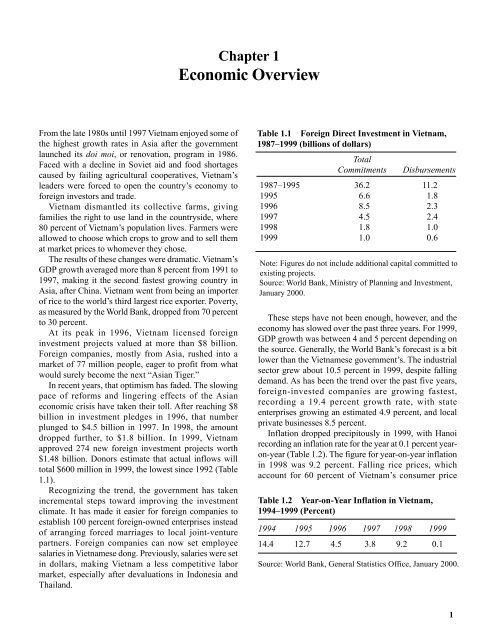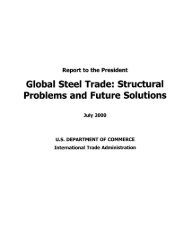Vietnam Environmental Technologies Export Market Plan
Vietnam Environmental Technologies Export Market Plan
Vietnam Environmental Technologies Export Market Plan
You also want an ePaper? Increase the reach of your titles
YUMPU automatically turns print PDFs into web optimized ePapers that Google loves.
Chapter 1<br />
Economic Overview<br />
From the late 1980s until 1997 <strong>Vietnam</strong> enjoyed some of<br />
the highest growth rates in Asia after the government<br />
launched its doi moi, or renovation, program in 1986.<br />
Faced with a decline in Soviet aid and food shortages<br />
caused by failing agricultural cooperatives, <strong>Vietnam</strong>’s<br />
leaders were forced to open the country’s economy to<br />
foreign investors and trade.<br />
<strong>Vietnam</strong> dismantled its collective farms, giving<br />
families the right to use land in the countryside, where<br />
80 percent of <strong>Vietnam</strong>’s population lives. Farmers were<br />
allowed to choose which crops to grow and to sell them<br />
at market prices to whomever they chose.<br />
The results of these changes were dramatic. <strong>Vietnam</strong>’s<br />
GDP growth averaged more than 8 percent from 1991 to<br />
1997, making it the second fastest growing country in<br />
Asia, after China. <strong>Vietnam</strong> went from being an importer<br />
of rice to the world’s third largest rice exporter. Poverty,<br />
as measured by the World Bank, dropped from 70 percent<br />
to 30 percent.<br />
At its peak in 1996, <strong>Vietnam</strong> licensed foreign<br />
investment projects valued at more than $8 billion.<br />
Foreign companies, mostly from Asia, rushed into a<br />
market of 77 million people, eager to profit from what<br />
would surely become the next “Asian Tiger.”<br />
In recent years, that optimism has faded. The slowing<br />
pace of reforms and lingering effects of the Asian<br />
economic crisis have taken their toll. After reaching $8<br />
billion in investment pledges in 1996, that number<br />
plunged to $4.5 billion in 1997. In 1998, the amount<br />
dropped further, to $1.8 billion. In 1999, <strong>Vietnam</strong><br />
approved 274 new foreign investment projects worth<br />
$1.48 billion. Donors estimate that actual inflows will<br />
total $600 million in 1999, the lowest since 1992 (Table<br />
1.1).<br />
Recognizing the trend, the government has taken<br />
incremental steps toward improving the investment<br />
climate. It has made it easier for foreign companies to<br />
establish 100 percent foreign-owned enterprises instead<br />
of arranging forced marriages to local joint-venture<br />
partners. Foreign companies can now set employee<br />
salaries in <strong>Vietnam</strong>ese dong. Previously, salaries were set<br />
in dollars, making <strong>Vietnam</strong> a less competitive labor<br />
market, especially after devaluations in Indonesia and<br />
Thailand.<br />
Table 1.1 Foreign Direct Investment in <strong>Vietnam</strong>,<br />
1987–1999 (billions of dollars)<br />
Total<br />
Commitments Disbursements<br />
1987–1995 36.2 11.2<br />
1995 6.6 1.8<br />
1996 8.5 2.3<br />
1997 4.5 2.4<br />
1998 1.8 1.0<br />
1999 1.0 0.6<br />
Note: Figures do not include additional capital committed to<br />
existing projects.<br />
Source: World Bank, Ministry of <strong>Plan</strong>ning and Investment,<br />
January 2000.<br />
These steps have not been enough, however, and the<br />
economy has slowed over the past three years. For 1999,<br />
GDP growth was between 4 and 5 percent depending on<br />
the source. Generally, the World Bank’s forecast is a bit<br />
lower than the <strong>Vietnam</strong>ese government’s. The industrial<br />
sector grew about 10.5 percent in 1999, despite falling<br />
demand. As has been the trend over the past five years,<br />
foreign-invested companies are growing fastest,<br />
recording a 19.4 percent growth rate, with state<br />
enterprises growing an estimated 4.9 percent, and local<br />
private businesses 8.5 percent.<br />
Inflation dropped precipitously in 1999, with Hanoi<br />
recording an inflation rate for the year at 0.1 percent yearon-year<br />
(Table 1.2). The figure for year-on-year inflation<br />
in 1998 was 9.2 percent. Falling rice prices, which<br />
account for 60 percent of <strong>Vietnam</strong>’s consumer price<br />
Table 1.2 Year-on-Year Inflation in <strong>Vietnam</strong>,<br />
1994–1999 (Percent)<br />
1994 1995 1996 1997 1998 1999<br />
14.4 12.7 4.5 3.8 9.2 0.1<br />
Source: World Bank, General Statistics Office, January 2000.<br />
<strong>Vietnam</strong> <strong>Export</strong> <strong>Market</strong> <strong>Plan</strong><br />
1
















